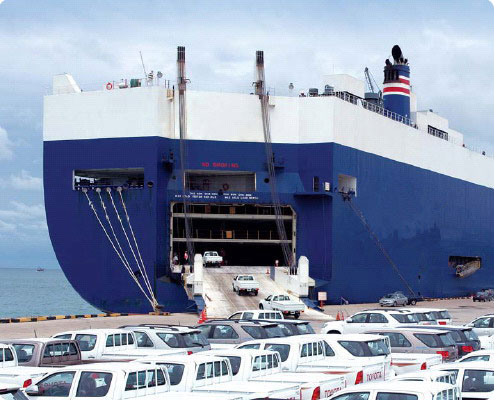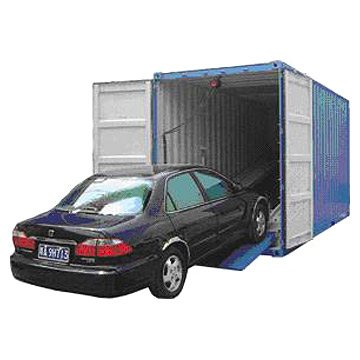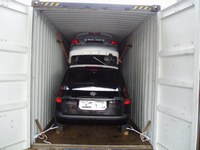Freight from the USA
|
|
|
|||
Customs Rules | Carriers Rules | Reading Rates | Avoiding Mistakes
Our primary business is freight LCL from the U.S.
If you can pack all your items in boxes or crate them, then our economy LCL freight service should meet your needs. By selecting the LCL service, calculate an LCL price quote using our online freight calculator. Watch this 3-minute video on YouTube about how the online freight calculator works. Discover the size of a cubic meter in this video.
However, motorized vehicles that require DMV (U.S. Department of Motor Vehicles) registration (autos, trucks, motorcycles, mopeds, jet skis, ATVs, etc.) will NOT be permitted to move out of the USA as LCL freight. U.S. Customs does not recognize any ocean carrier's warehouse (Container Freight Station - CFS) as an inspection site.
Currently, we do not support international shipping services for motor-driven units that require registration with the U.S. Department of Motor Vehicles. This webpage is intended for general informational purposes only.
Regarding Global Cargo Transportation by sea, any motor-driven units requiring DMV registration (autos, trucks, motorcycles, mopeds, jet skis, ATVs) are considered motor vehicles by U.S. Customs. Exporting them overseas, while using sea freight, is subject to special procedures related to U.S. Customs. It makes the procedures different from those for exporting general commodities overseas.
Note: This web page does not cover all the specifics of transporting motor-driven units from the USA in all circumstances. A variety of special U.S. regulations govern such procedures. However, this article should provide you with a comprehensive picture of the subject.
YOU MAY SHIP MOTOR VEHICLES BY SEA IN TWO WAYS:


LCL freight service is permitted to ship auto parts from the USA.
If the cargo contains any motor-driven vehicle, U.S. Customs will require the original title and at least three copies of the title.
Titles and copies (front and back) must be validated before the entire shipment can be cleared for sailing from the USA.
Titles are considered essential and mandatory documents in such shipments. They must be provided to U.S. Customs at the port of origin (the ocean carrier's Container Yard - CY for containers or the pier for RORO). If there are any liens against the vehicle, a notarized letter from the lien holder authorizing its export must accompany the title. However, U.S. Customs will be less likely to approve something with liens for export from the USA.
Suppose the owner, as in the title, cannot accompany the vehicle to the port of departure. In that case, the owner must issue a power of attorney to the person or company representing them before customs at the port of departure. If you ship cars consolidated in containers, the company is a quality loading warehouse specializing in loading, securing, and conveying motor-driven units.
Most countries require that the original titles be presented to the destination when motor vehicles are recovered. If they had been sold to the consignee (the recipient at the destination), the bill of sale should also be presented at the destination.
After validating titles, U.S. Customs stamps them, approves them for export, and returns them to the shippers or authorized persons. As soon as the shipment passes through all the formalities, we strongly recommend mailing all original documents to the consignee without delay to avoid potential extra charges at the destination due to a lack of proper documentation.
If motor vehicles are in containers, their doors must not be locked until U.S. Customs officers have checked the Vehicle Identification Numbers (VINs) inside the containers. Remember that when loading any motor-driven unit into containers, you must provide the officers with easy access to the Vehicle Identification Numbers (VINs), typically located on the left-hand side, under the windshields. Otherwise, they may reject containers, and it may be required to be returned to a loading dock for reloading.
Note: If you are loading and securing multimodal containers on your own at your site, unless you are a professional in loading such containers, we strongly recommend hiring quality loading personnel or an international moving company experienced in loading containers with such commodities.
EXPORTING MOTOR-DRIVEN UNITS RORO:
Unless a motor-driven unit is not on the trailer (e.g., boats on trailers with an empty gas tank), it must be running and filled with gas, but no more than half of the tank (1/4 is recommended). Ignition keys must accompany everything shipped roll-on/roll-off.

Motor vehicles must be in running condition to be accepted by ocean carriers' roll-on/roll-off shipments. If they are delivered for the roll-on/roll-off shipment to an RORO ocean carrier's pier in non-running condition, then extra charges related to non-runners' towing on/off the RORO vessel apply.
Vehicles shipped roll-on/roll-off on trailers (such as boats, jets, and motorcycles) are subject to safety requirements similar to those for cars shipped in containers. See below.
IMPORTANT: If you ship RORO, you cannot send anything inside except factory-installed equipment. The carrier will not be liable for additional items shipped roll-on/roll-off.
EXPORTING CARS INSIDE OF CONTAINERS:
Moving automobils in containers, unlike RORO, requires that:

If you ship CARS IN CONTAINERS CONSOLIDATED WITH OTHER OWNERS, you should not use their salons and trunks as additional room for your shipment. Extra items inside your auto, except for factory-installed equipment, may result in problems with U.S. and destination customs. However, if you still insist on putting something in the salons or trunks of your autos, accept the risk of the issues and are allowed to do that by an international shipping company, then ensure that the VIN is not blocked from view when a customs officer matches the VIN with the titles of your cars.
Note: We recommend considering our ECONOMY LCL service if you ship only auto parts from the USA, which is permitted.
Suppose your automobile is in a container belonging to a single shipper. In that case, you can use all the spare rooms of the container, including salons and trunks, to ship additional cargo alongside the automobile. However, in this case, in addition to the original titles, you must provide a complete and accurate packing/inventory list of all items sent in the container, along with the vehicles.
You may refer to services from quality loading warehouses that specialize in loading and securing such containers. These docks may also complete all U.S. Customs formalities on behalf of shippers.
Suppose shippers pick up containers from the ocean carriers' container yards to load them onto their ships. Upon approval, a U.S. Freight Forwarder may offer bookings from steamship lines for FCL shipments to transport containers with autos overseas. Then, shippers will be held responsible for completing all procedures related to pickups and returning containers, loading and securing exported automobiles in the containers, as well as export formalities, among other tasks. Any surcharges that, for any reason, may be added by steamship lines to prices confirmed in bookings will be charged to the shipper's account.
Suppose you are moving overseas from the USA. In that case, you may compare international shipping costs offered by international moving companies versus those of global shipping companies (freight forwarders, NVOCCs, VOCC). You may likely find that the services of international moving companies appear more convenient than those of a global shipping company. However, suppose you understand how the industry works and compare costs from an international moving company with those from other global cargo transportation companies. In that case, you can save hundreds or thousands of dollars.
RATES USING RORO SERVICE
There are no standard roll-on/roll-off freight rates. Rates vary depending on the carrier's criteria and types of vessels.

Since RORO vessels' desks are designed for different types of wheeled cargo (you may compare of cars of small and mid-sizes to of giant excavators, for example), then, in general, roll-on/roll-off rates in price quotes offered, will be based on the overall volume of your shipment in cubic feet (CBF) or cubic meters (CBM). It calculates based on measurements provided by shippers. RORO rates also depend on the type of motorized unit. Roll-on/roll-off ocean rates per CBF or CBM will generally vary depending on the size when shipped RORO.
The exemption would be for rates for small and mid-size cars. If you use a roll-on/roll-off service, the rates may be a lump sum in US dollars based on the makes, models, and years of the units. However, it would be helpful if you understood that, in reality, to obtain a lump sum rate, RORO carriers have created and used special ocean rate matrices in their practice, which refer to overall volumes of cars shipped from the US based on their make, model, and year information. RORO freight rates are based on their overall volume. For example, autos up to 600 cubic feet of total volume and up to 1.6 meters high - $1,300 lump sum + BAF & CAF, etc.
IMPORTANT: Your RORO shipment will be measured at an SSL pier (Steam Ship Line's pier). Suppose the unit's overall dimensions retrieved by SSL will differ from those given by the shipper when booking their shipment. In that case, additional international shipping costs will apply to the total cost initially quoted to the shipper. Your total freight cost will be calculated as the total volume of your unit in CBF or CBM multiplied by the rate per CBF or CBM, depending on the unit type, plus surcharges on the freight rate.
In roll-on/roll-off operations, carriers utilize various types of cube tables, including those designed for cars. As long as a shipper provides the vehicle's make, model, and year, a carrier can directly define the total volume in cubic feet (CFB) or cubic meters (CBM). Sea freight is offered on a CBF (Cubic Feet) or CBM (Cubic Meters) basis to calculate the total international shipping cost.
EXPORTING CARS IN CONTAINERS
Rates for vehicles in containers (and other types of smaller motorized units) can be as follows:
1. OCEAN FREIGHT RATE FOR CARS PER ENTIRE CONTAINER: The price is only the ocean freight. I.e., per an FCL booking scheduled with a steamship line only. That means the shipper is responsible for stuffing and securing autos in containers. Shippers are held accountable for title validation with U.S. Customs and Border Protection. You should read and understand these rates for FCL – Full Container Load, including the commodity type (new or used), etc. Often, FCL rates (costs related to a booking offered to a shipper) on shipments of containers with motorized units will include additional surcharges on top of the sea freight rate. Certain carriers do not accept vehicles in containers.
2. OCEAN FREIGHT RATE PER ONE CAR CONSOLIDATED IN A CONTAINER WITH OTHER CARS, or PER ENTIRE CONTAINER containing two, three, or more, which is loaded and secured on behalf of one shipper/owner:
Generally, shipped autos will be consolidated in a 40' High Cube container. Sometimes, using the services of international shipping companies can be the most convenient and economical way. However, this service is not always available. This rate includes loading and securing vehicles in a container by a professional loading company. They will pass U.S. Customs formalities with the title(s).
The shipper (or freight forwarder on the shipper's behalf) should arrange for the delivery of the car(s) to a parking lot of a reputable loading company and leave it there, along with all required documents for the shipment by sea. If they are ready to be loaded in containers, this quality loading company should handle everything, including passing U.S. customs formalities. As long as vehicles have crossed everything, all documents will be returned to the shipper or (by shipper request) forwarded directly to the consignee or a destination receiving terminal.
Depending on the size of the autos, four to five of them may be consolidated in one multimodal 40' or 40HC container. However, only three or even two can be in a container to ensure a quality load. If you ship luxury or antique (valued) automotive, we recommend using an entire 20' or 40' container.
If you ship, only one car is consolidated with others. Therefore, the freight rate should be offered as a lump sum per car, depending on the make, model, year, and dimensions (size). For example: Toyota Corolla, 2004 - $750 lump sum + BAF & CAF, etc. And finally, like this:
As a rule, rates for consolidated vehicles are all-in/"Free Out." This includes loading and securing the item in a container, U.S. Customs formalities, and the freight cost to ship it to the destination. Not included:
1. SED (Shipper's Export Declaration) in AES (optional) - $35
2. Insurance (optional) - 1.1 - 1.5% @ value declared
3. Destination charges
Suppose you ship numerous cars of different makes and models. In that case, the rate should be offered per entire container, including an offer for the most efficient way of staffing and securing them. An international shipping company (freight forwarder or NVOCC) will then discuss with the loading dock and specify how many items can fit in a specific container for global transportation from the USA. For example, the rate for 1 x 40HC containing two 2003 Dodge Neons and one 2006 Chevrolet Cavalier is $ 2,370 + BAF & CAF, including stuffing in the container and export formalities.
A. Original titles for cars shipped from the USA must be furnished at the destination
According to regulations of most countries worldwide, the original titles must be presented upon arrival of the imported automobiles. If a vehicle was sold to the consignee (recipient) before shipping overseas, the bill of sale should also be furnished at the destination. For example, as soon as your car(s) have passed U.S. customs, always express mail all original documents to the consignee without delay to avoid extra charges at the destination due to a lack of proper documentation.
If all of this is new business for you, we suggest discussing the cost of recovering your vehicle at your destination country with someone experienced in the industry. This would also include procedures for recovering vehicles at destinations, as well as export formalities for autos imported from the USA. It can be an individual you can trust, a freight forwarder, a customs broker in your destination country, or others.
B. Do not confuse services from a global shipping company (Freight Forwarder, NVOCC) with assistance from an international moving company
Procedures and prices from a global shipping company differ from those of international moving companies (as a rule, related to moving household goods overseas).
With an international moving company, you can get a container delivered to your door and have your car(s) loaded and secured by the international moving company along with the rest of your household goods.
Most of the time, global cargo transportation companies do not offer such a service. The shipper is responsible for loading and securing cars in containers for the shipment unless you request a load in a quality loading warehouse. Always compare the prices and service packages offered by global transportation companies (freight forwarders, NVOCC) to those of international moving companies.
C. Always be aware of origin and destination charges, which are not included in rates.
Generally, a global cargo transportation company's sea freight rates include port fees at the origin.
However, should your vehicle need to be stored at the port of origin or a parking lot of a quality loading warehouse for any reason (e.g., lack of proper documents, waiting time for other vehicles coming to be consolidated in the same container, etc.), storage fees, etc., will increase the international shipping cost of your shipment and are the shipper's responsibility. Please plan your shipment from the US.
International freight prices in quotes do not include storage fees (if any), handling, or customs-related charges at the destinations.
D. Shipper's Responsibilities in Filing Documents.
The shipper should clearly understand that they are entirely responsible for the description and legality of the commodity, as well as the sufficiency of the documents submitted for a shipment.
A carrier's bill of lading is the final document that serves as a title for the goods shipped from the United States overseas. As a rule, states' SHIPPER'S LOAD AND COUNTS' and 'SAID BY SHIPPER TO CONTAIN.' That means a direct carrier (and a freight forwarder representing this carrier) is not responsible for the shipper's information when booking an international shipment.
A freight forwarder should guide shippers through the complexity of shipment procedures. However, the shipper is responsible for providing all documents that the officials of the origin and destination countries require.
Below is the list of commonly used documents required to be submitted when you ship motor-driven units from the USA overseas using sea freight:
|
|